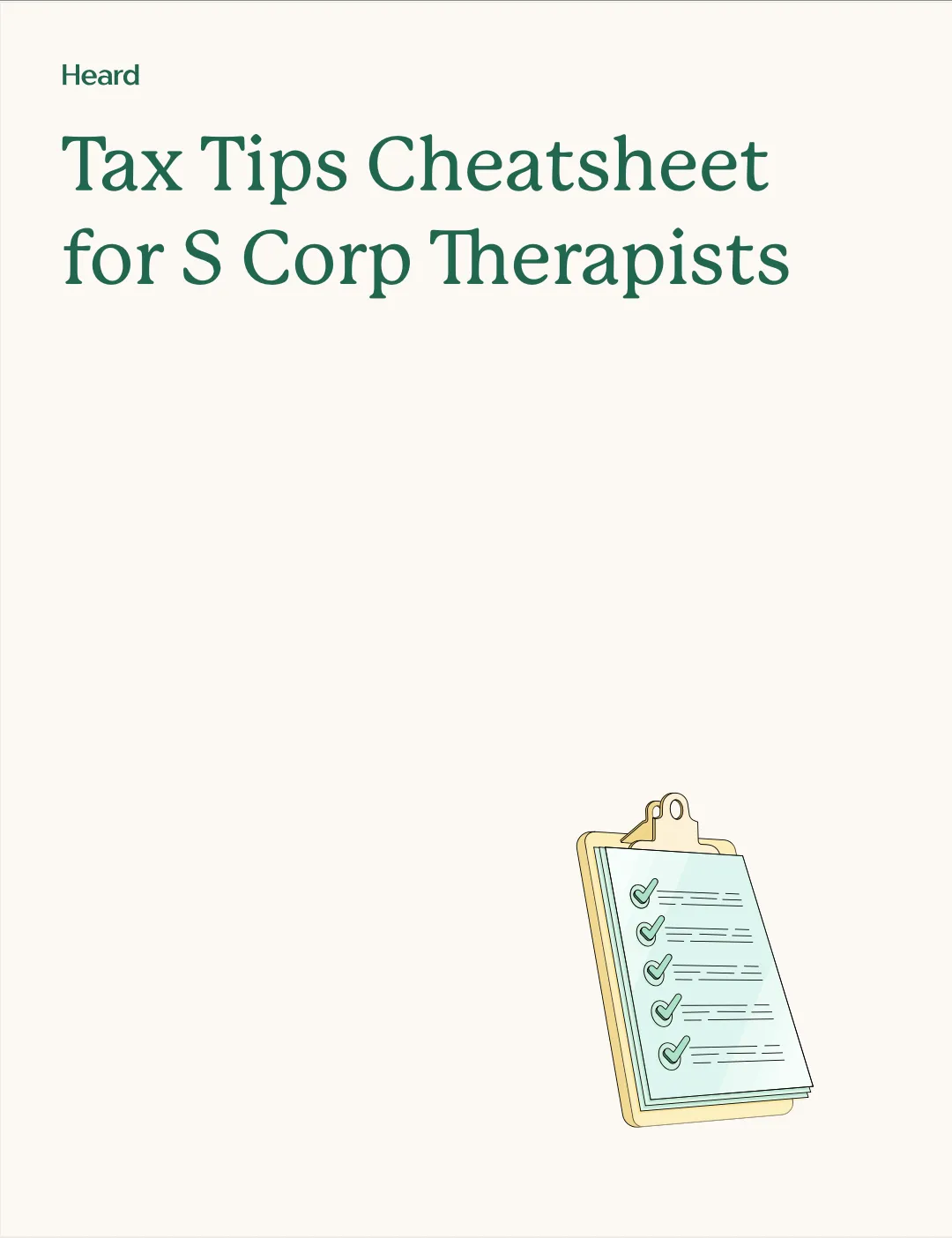Hoping to reduce your therapy practice’s tax burden this year?
Our article on year-end financial planning for therapists covers the basics, particularly if you’re a sole proprietor.
But if your practice is an S corp, the different tax structure—and the fact that you’re both a business owner and an employee—open up new opportunities to save and plan.
{{resource}}
Sole prop vs. S corp: What’s the difference for therapists?
When you’re a sole proprietor, you and your business are one and the same. All income your practice earns counts as self-employment income, and you pay 15.3% self-employment tax on it.
When you’re an S corp, you and your business are distinct from one another. True, all the income your practice earns counts as your personal income (and helps to determine your tax bracket), but not all of it is self-employment income.
Most solo therapists who elect S corp status work as employees of their own therapy practices, while also retaining 100% ownership of the S corp. They pay the equivalent of self-employment tax (7.65% payroll tax withheld from each paycheck, and a matching 7.65% contributed by the business) on their salary. But they don’t pay that tax on income they receive as distributions.
For a more detailed breakdown, check out our Complete Guide to S Corporations for Therapists.
Write off LLC and S corp costs
Whether you’re converting your sole proprietorship into an S corp, or you’re in the midst of launching your new practice and starting an S corp from scratch, all the fees associated with forming your new business structure are tax deductible.
Those include:
- LLC (or equivalent) filing and registration fees
- Doing Business As (DBA) fees
- Attorney fees
- Any costs associated with completing or filing paperwork
- The cost of completing articles of organization
You need to deduct these fees on this year’s tax return in order to reduce your tax burden. And you also need to make sure you have the paperwork—receipts or other proof of payment—to back up your claims. So get started ASAP.
Once your business is up and running, you can deduct the cost of maintaining LLC and S corp status. That includes the increased bookkeeping and accounting fees S corps typically pay. It also includes franchise tax, which in some states—like California, which charges business owners $800 each year to remain incorporated—can be pricey.
Max out contributions to retirement accounts
By contributing before year-end to traditional IRA and 401(k) retirement accounts you can reduce your tax burden for the year. With traditional IRA and 401(k) accounts, when you make contributions, the tax on those contributions is deferred until the time you withdraw the funds.
This applies to both employer contributions and employee contributions. It’s especially important when it comes to 401(k)s. For instance, in 2025, an employee under the age of 50 can contribute up to $23,500 to their 401(k), while the total contribution limit (employer and employee combined) is $70,000—meaning their employer can contribute up to $46,500 before the end of the year, reducing their taxable income.
{{resource}}
Top up your Health Savings Account (HSA)
If you have an HSA, adding funds before the end of the year—either as an employer or an employee—lowers your total taxable income.
In our guide to HSAs for therapists, we recommend maintaining a “cash goal” amount in your HSA. Your cash goal is the amount you need to cover all your routine medical treatments for the year that cost less than the deductible and out-of-pocket limits of your health insurance, plus what you would need to cover the deductible in the event of emergency treatment.
For instance, if your health insurance deductible is $1,500, and your out-of-pocket limit for the year is $8,000, the cash in your HSA should cover the year’s combined costs that fall under those limits, plus the entire deductible in case of an accident.
If you anticipate your total medical expenses for the year (eg. doctor visits, dental checkups, vision care‚ ongoing prescriptions) to come to $700, you should ensure you have $700 in your HSA to cover them. On top of that, you should also keep $1,500 on hand in your HSA—so you can cover the deductible in case you need expensive emergency treatment.
Do the math and determine whether you have enough in your HSA to cover next year’s anticipated medical expenses, plus the deductible. (You can project next year’s expenses by looking at your costs for the current year so far.) If you don’t have enough in your account, top up your HSA for the year ahead.
Remember, HSA contributions, withdrawals, and earnings (on investments) are all tax free. Learn more from our Complete Guide to HSAs for Therapists.
Write off health insurance premiums
If your business pays your health insurance premiums as part of your compensation as an employee, you can write off the cost on Form 1040.
In order to qualify for this deduction:
- Your business must have established your healthcare policy
- Your business must pay your healthcare premiums, either directly or by compensating you
- Your healthcare premiums must be correctly reported on both your business and personal returns (that means reporting it as part of your compensation on Form W-2)
- You must not have access to any other health plan (e.g. through your spouse’s employer)
To claim this deduction, calculate the total deductible amount using Form 7206. Enter the total amount on Form 1040, Schedule 1, Line 17.
Run a reasonable compensation report
The best business moves are the ones that save you tax dollars for the current year. But in some cases the only way to save is by preparing for the year to come.
Running a reasonable compensation report is one of those.
When you’re employed by your own S corp, the IRS requires you to earn a reasonable salary. A reasonable salary, in this case, is determined by a number of factors—your location, your experience and certification levels, and the amount similar professionals earn.
Why? Because the IRS doesn’t want you paying yourself a tiny salary and taking the bulk of your earnings as owner’s distributions. Remember, you pay payroll taxes (totalling 15.3%) on your salary, but not on owner’s distributions. By favoring one form of compensation over the other, you could theoretically save a significant amount in taxes.
Don’t worry—you can still save on taxes with the S corp structure by paying yourself a reasonable salary and taking additional income as distributions. And in order to maximize your earnings, you should aim to pay yourself the smallest salary possible while sticking to the IRS’s expectations of a reasonable salary.
Enter the reasonable compensation report. Reasonable salaries are notoriously difficult to determine. Even if you check the average annual earnings of therapists in your area, you could end up paying less than you should (putting yourself in danger of IRS penalties) or—and this can be almost as bad—paying yourself too much. Remember, for every $1.00 you pay yourself over the reasonable salary limit, you’re paying an additional $0.15 in taxes. And that adds up.
Consider hiring a CPA or an accounting firm to run a reasonable compensation report for you. They can look at their data, crunch the numbers, and help you set a reasonable salary that keeps you in the IRS’s good books without leaving tax savings on the table.
Then, set your salary for next year. With any luck, it will be lower than it is now, and your tax savings next year will increase.
Word to the wise: Reasonable compensation reports cost money, and it’s always a gamble paying upfront for one. You might find out your current salary is just perfect, in which case all you get for your money is peace of mind. Plus, there are companies that specialize in delivering reasonable compensation reports, sometimes at inflated prices. Talk to your current accountant before hiring someone new to run a report for you.
{{resource}}
Clear up Accounts Payable (AP) and (maybe) Accounts Receivable (AR)
If you use the cash basis method of accounting, you can skip this section.
If you’ve got business bills to pay and the end of the year is approaching, now’s the time to pony up. Clearing your AP before the end of the year reduces your taxable income (assuming you’re paying for deductible business expenses), which in turn reduces your tax burden.
Besides lowering your tax bill, an empty AP account means you go into the new year with a clean slate. It’s one less thing to worry about when tax season hits.
For the same reason—that refreshing sense you get from a ledger full of settled accounts—you may want to chase down any outstanding AR and make sure you get paid before the year is up.
Keep in mind, though, that any payment you receive will increase your income, offsetting whatever reduction to income you enjoyed by paying your bills.
So you may want to wait until the new year before following up on outstanding bills, or even—if December 31st is coming up fast—even wait until the new year arrives before you bill clients. Deferring income is a legitimate strategy for lowering your tax bill for the year; just be sure you’re not inconveniencing your clients by holding back your invoices until the new year rings in.
Choose the best home office deduction for your practice
Whether you’ve already claimed the home office deduction in the past or it’s your first time claiming it, take time to review your calculation method.
There are two ways of calculating your home office deduction: the standard method and the simplified method. The best approach is to use the method that results in the largest deduction.
If your home office expenses have changed at all over the past year—if the cost of rent or utilities has gone up, for instance—it could affect which calculation method results in the highest deduction.
Using the standard method, you calculate the total cost of maintaining your home (rent or mortgage, utilities, property taxes, etc.), then calculate your home office expense based on what percentage of your home’s square footage your home office occupies.
For instance, suppose your total housing cost for the year is $36,000, and your home is 3000 square feet. If your home office is 300 square feet, occupying 10% of your home, you may deduct $3,600 in home office expenses.
The simplified method applies a flat rate of expense to each square foot of your office, up to a maximum of 300 square feet. The rate is $5. If your home office is 300 square feet, you can deduct $1,500 in home office expenses.
Following this example, you can deduct over twice as much in business expenses from your taxes using the standard method rather than the simplified method. But this doesn’t always apply—it depends on your particular situation. So take the time to review your method this year and make sure it’s saving you the maximum amount possible.
Rent your home to your business
The Section 280A deduction allows you to rent your home to your business for up to 14 days of the year. The cost of the rental is a tax-deductible business expense for your S corp, and the rental income is tax-free.
The cost of the rental should be based on renting comparable spaces in the same region, and the rental must exclusively serve a business purpose. For instance, you might host a workshop or a networking event for therapists in your area.
It’s important to keep clear records of all expenses and income, and qualifying business activities your S corp undertakes when renting your home. Because of the intricacies involved, consult with your CPA or tax advisor before claiming this deduction.
{{resource}}
Consider hiring family members
There’s no particular tax deduction you can claim if you hire family members. But by hiring them and paying them in untaxed benefits—such as health coverage, educational fees, and assorted fringe benefits—you can both save on taxes.
For instance, if you have a young family member who is interested in studying business administration, you may be able to hire them to work as a junior office manager at your practice. As compensation, you cover the cost of their business admin classes at a local college. The tuition, since it’s compensation, is a tax write-off for your business. But it’s also untaxed at the employee end.
For a more detailed breakdown, check out Can You Hire Family Members to Work at your Therapy Practice?
Make family members shareholders
If you would normally give money to a particular family member personally, you can save on taxes by making them a shareholder in your practice and transferring the funds as distributions.
This strategy is most commonly used to transfer funds to family members, but it can be used to transfer funds to anybody.
This is particularly beneficial if the person to whom you transfer the funds is in a lower tax bracket.
Example: Your practice’s taxable income is $120,000. Your college-aged child’s taxable income is $30,000. You’d like to give them $10,000 towards next year’s school tuition.
To do so out of pocket, you would need to spend $13,000: The $10,000 you give them from your personal earnings is subject to about $3,000 income tax.
However, if the money goes directly from your S corp to your child as a shareholder distribution, you don’t pay income tax on it. Rather, your child pays about $1,700 on their end. It’s less than $3,000 because they belong to a lower tax bracket. If you cover that expense yourself, you end up paying $11,700 rather than $13,000 to contribute $10,000 toward their tuition.
This method is also useful for distributing funds to elderly family members who need support during their retirement, and belong to tax brackets lower than your own. Just make sure to go through all the necessary steps to make them a valid shareholder in your S corporation.
—
Looking for more smart business moves to make before tax season hits? Check out our article on year-end financial planning for therapists.
This post is to be used for informational purposes only and does not constitute legal, business, or tax advice. Each person should consult their own attorney, business advisor, or tax advisor with respect to matters referenced in this post.
Bryce Warnes is a West Coast writer specializing in small business finances.
{{cta}}
Manage your bookkeeping, taxes, and payroll—all in one place.

Discover more. Get our newsletter.
Get free articles, guides, and tools developed by our experts to help you understand and manage your private practice finances.





